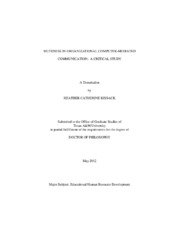| dc.description.abstract | The purpose of this feminist critical discourse analysis was to uncover whether or not, and how, muteness of female-preferential voice occurs within written organizational computer-mediated communication. Qualitative textual analysis was used to analyze 18 discussion forums from three voluntary professional associations representing highly male-populated (mechanical engineering), gender neutral (training and development), and highly female-populated (nursing) industries. Discussion posting participants were categorized for using male-preferential (MP), female-preferential (FP), or neutral (N) language. MP and FP interactions were then analyzed for themes of muting and muteness.
Seven major findings within three analytic categories emerged from this study. First, with regards to preferential language use by industry site, all three sites’ participants used FP language more than MP language. In fact, 158 of the 246 total participants were categorized as FP language users and 17 of the 18 forums were initiated by a FP participant. Additionally, although overall, modals and hedges were the most prevalent FP language characteristics and opinions were the most prevalent MP language characteristic, this differed across industry site. Implications for scaling preferential language dimensions along a continuum from highly feminine to highly masculine are discussed.
Second, regarding strategies of maintaining male dominance (muting), it was found that MP language dimensions were used more often by MP participants when interacting with FP participants. Themes of muting strategies such as overstating one’s knowledge base were found in MP language. FP participants, on the other hand, cloak their opinions in subordinating language; thus understating their knowledge. This context allows MP language users to trivialize FP language users’ postings. Additionally, the use of masculine pronouns was equal to the use of feminine pronouns despite the majority of FP participants; and FP participants were overwhelmingly more likely to use masculine pronouns that MP participants were likely to use feminine pronouns.
Finally, with regards to strategies of FP communication during interactions with MP language users (muteness), FP participants engaged mostly in respectful communication as a strategy to communicate. The communication strategy used least was confrontation. An emergent strategy of communication was the increased use of metaphors by FP participants when interacting with MP participants. | en |


